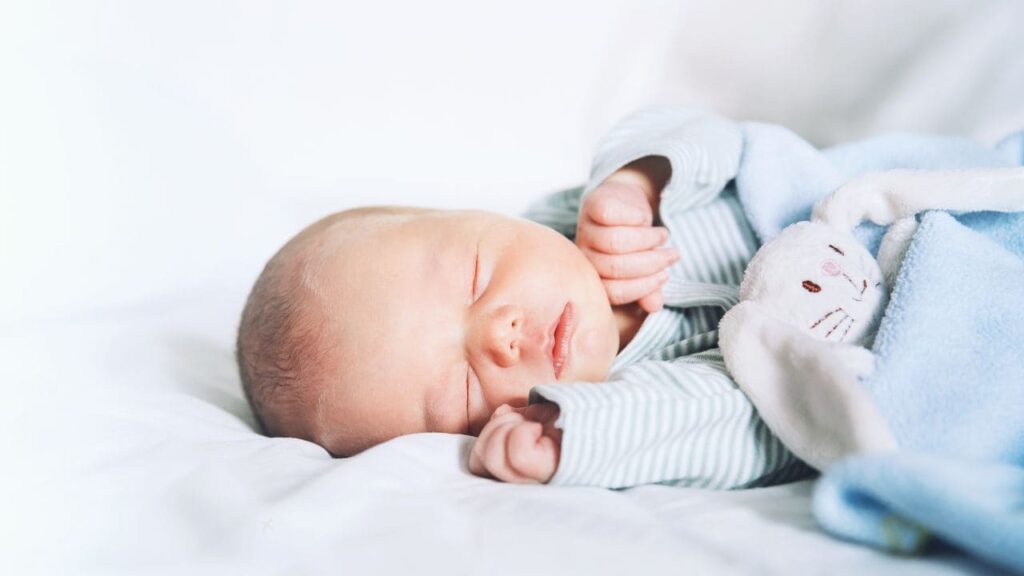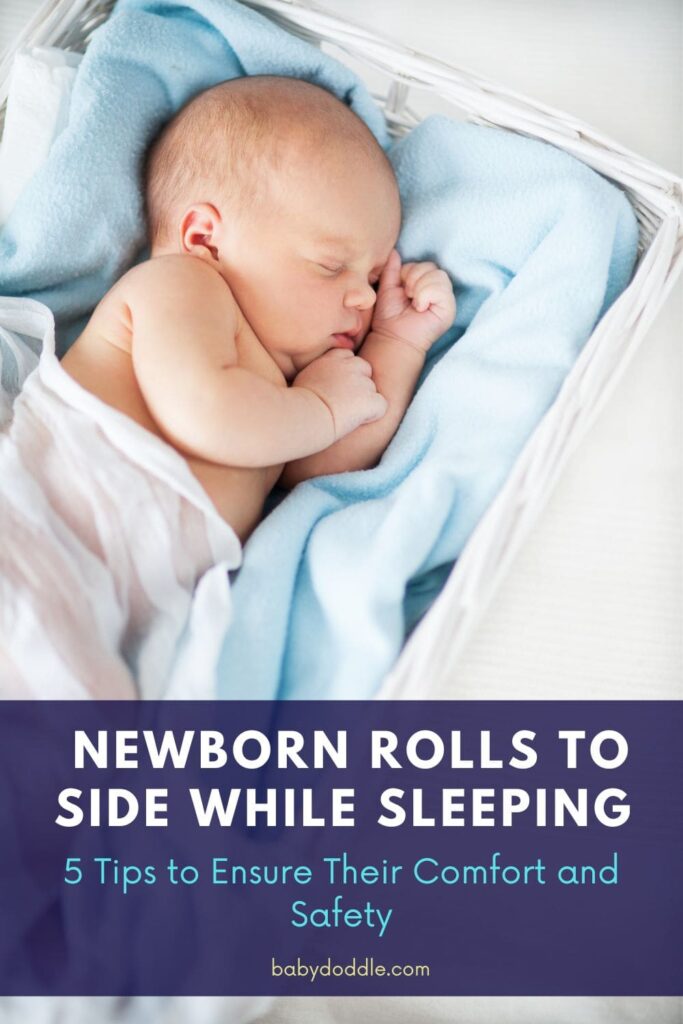As a new parent, a few things made my heart stop like going into the nursery and seeing my tiny newborn rolled over onto their side while sleeping. Were they still breathing okay? Were they stuck? While startling, I soon learned that newborns rolling to their side in sleep is very common and not immediately cause for concern—as long as you take the right precautions to create a safe sleep environment.
In this post, we’ll cover when and why the newborn roll-over starts happening, dangers to be aware of, tips to reduce risk and handle roll-overs properly, and when you can feel comfortable letting your little one snooze on their side. As our pediatrician likes to say: “This too shall pass!” Rest assured, the phase of unpredictable mobility during sleep passes more quickly than you think.

Why Do Newborns Start Rolling in Their Sleep?
Many parents are surprised when their tiny 1-2 month-old baby first starts exhibiting this new skill. You may go in to check on them during a nap and discover they’ve fully flipped themselves over! Rest assured, early mobility milestones like rolling are very normal, even if shocking for unsuspecting moms and dads.
Rolling begins due to two key developmental factors. First, young infants lack head control and core body strength. Their little heads are still disproportionately heavy compared to the rest of them, and their muscles have not built up enough to resist gravity’s pull. They tend to flail their arms and legs increasingly vigorously, gaining coordination. All this movement can translate into an accidental roll. Which brings us to the next reason…
…they roll because it feels good! Turning into a new position brings comfort. At around 2 months old, babies realize how good stretching feels after being curled up in one posture for too long. They’ll twist, turn, and wiggle trying to get comfy. This builds core strength that eventually leads to intentional rolling. But at first, do not be fooled – they are not purposefully flipping themselves over just yet. It’s merely a byproduct of flailing movements hitting the sweet spot that eases them onto their side.
Now that you understand early mobility is developmentally normal, let’s explore appropriate expectations for when rolling begins:
- 4-6 weeks old – earliest accidental rollers, but very rare
- 8 weeks old – earliest purposeful back-to-side rolling, again uncommon
- 3-4 months old – the peak of first-time rollovers, especially accidental
- 5-6 months old – traditionally when most babies can roll back-to-front intentionally
Of course, every child progresses differently physically and mentally based on genes and environment. If you have specific concerns about your baby’s motor development, chat with your pediatrician. They can provide personalized guidance on milestones.
| Age | Milestone |
|---|---|
| 0-8 weeks | No real rolling |
| 2-3 months | Accidental side rolls |
| 4 months | Back-to-side rolling |
| 5 months | Front-to-back rolling |
| 6 months | Bidirectional rolling |
Causes of Newborns Unexpectedly Rolling During Sleep
Newborns first start exhibiting rolling behavior during sleep before most parents expect their tiny babies to show such advanced mobility skills. What causes babies barely 2-3 months old to suddenly fully flip over without warning? Several interconnected factors contribute to these early accidental rolls.
The rapid growth of arm and leg muscles naturally occurs in all infants from involuntary reflex movements they cannot control. Random flailing and jerking of limbs frequently take place, which slowly strengthens and coordinates muscle groups. As torso length also lengthens thanks to growth spurts in the first 6 months, a newborn’s center of balance shifts. Swaddling wraps that previously kept infants snugly contained can start feeling too tight and trigger efforts to break free.
Additionally, crib mattresses that feel ultra-firm during the earliest weeks start compressing and contorting more easily from daily use over time. Consider checking your mattress fit every 2 weeks when unexpected rolls begin happening. Has it developed gaps allowing limbs to slip into crevices? This further enables babies to leverage the momentum created from reflex kicks. A final element involves parents naturally graduating from maximum alertness during first weeks at home to slightly more multitasking around the house during months 2-4.
Unfortunately, these predictable factors can intersect, leading loving, attentive moms and dads to suddenly discover their baby flipped onto their side despite following all the “safe sleep rules”. Understanding what elements commonly trigger early mobility can help parents proactively troubleshoot if rolls start happening consistently. Remaining calm yet hypervigilant during this phase remains key to preventing emergencies before strength builds for safe, intentional rolling in both directions.

Is Rolling Onto the Side Dangerous for Newborns?
While rolling itself if developmentally normal and cause for celebration, supervision remains essential during this transitionary period. When babies roll fully onto their side or front prematurely without strength and stamina built up, risks include:
- Difficulty breathing – If a newborn’s face presses into the mattress accidentally, their little airways can become blocked or constricted. Always place infants on their backs to sleep.
- Entrapment – If a partially mobile baby flips completely onto their front, it often lack the core strength to roll itself back again. This is why cribs certified as safe infant sleeping spaces have vertical slats less than 2 3/8 inches apart – wider than this, and a baby’s arm or leg could slip through and get trapped.
- Sudden Infant Death Syndrome (SIDS) – Tragically, babies under 12 months old remain at the highest risk for Sudden Infant Death Syndrome when placed incorrectly or unsafely to sleep. That’s why pediatricians strongly advise putting infants ONLY on their back to sleep to reduce SIDS risk. Side-sleeping is not considered medically safe.
- Strangulation – Loose bedding like blankets, sleep positioners, crib bumpers, and stuffed animals can pose suffocation or strangulation risk to tiny babies who lack mobility to free themselves if fabric covers their faces.
As you can see, supervision and correct sleep safety steps remain essential during the months when rolling first emerges. So let’s explore tips to reduce risks!
5 Tips to Keep Your Newborn Safe From Rolling
1. Always Place Baby on Their Back to Sleep – No Exceptions
The American Academy of Pediatrics strongly recommends back-sleeping as the safest infant sleep position, reducing the chances of suffocation or SIDS. I know it can be tempting to place a rolly baby on their side or front if that seems to help them rest easier. But resist the urge and stick strictly to the back sleep guidelines.
2. Transition from Swaddles to Sleep Sacks
Many babies love being swaddled, with their arms wrapped snugly to prevent flailing that startles them awake. However, once rolling begins, swaddling becomes UNSAFE – a tightly wrapped blanket prevents babies from flipping back again if they accidentally roll forward.
Instead, use swaddle transition products like Zipadee Zip Sleep Sacks that wrap the body but leave arms free to roll safely.
3. Try Wedge-Style Sleep Positioners, But Use With Caution
Some parents swear by infant sleep positioners – wedge-shaped supports placed along each side to keep babies comfortably on their backs. They allow newborns that infant “snuggled” feeling while preventing lateral rollovers.
However, no products replace supervision. Plus, some older-style positioners got banned for posing risks. Consult your pediatrician before trying one. Newer options aim to improve safety. But checking frequently on a rolling baby remains key.
4. Ensure Mattress Firms Up Well
Extra-firm crib mattresses support infant development, making it harder for little ones to sink into soft bedding and accidentally flip themselves over. Ensure the mattress snugly fits your crib frame without leaving wide gaps for limbs to slip into. No more than two fingers width between mattress and crib side. A tight sheet also helps reduce rollover risk.
5. Check on Your Newborn Frequently
While back-sleeping in a bare crib remains ideal, unfortunately, life gets chaotic. Despite best intentions, your baby may end up napping while you fold laundry in another room. Or you lay them down drowsy but awake at night and don’t notice when they flip over 30 minutes later.
Set a loud baby monitor, check at least every 15-20 minutes, or sleep in rotations to supervise. Catching rollovers early allows for quickly correcting the baby’s position to keep their airway protected.
While these proactive steps help reduce risk, what do you do if your infant still occasionally rolls fully onto their side before showing readiness? Let’s explore best practices.

What Should You Do If Your Baby Rolls Onto Their Side?
Startle-awakenings from discovering your newborn snoozing on their side strike fear in most parents’ hearts. But try to respond calmly and systematically. Rushing in panicked risks further disturbing their slumber.
Gently pick up your baby, cradling their head and neck aligned with their back as you transport them to avoid injury. Slowly roll them onto their back in the crib, keeping sideways pressure on their torso if needed to help reposition while avoiding jerky movements.
If your child stirs fussily or fully awakens, employ soothing techniques like shushing sounds, gentle pats or rocks, or offering a pacifier to help them drift back asleep. Consider gas drops or probiotic drops if a tummy ache could be causing discomfort driving them to roll.
While frustrating to have a baby stir just as you’ve tipped back into dreamland yourself, remember most pediatricians consider periodic disrupted sleep for parents a small and temporary price to pay during infancy to maintain constant supervision ensuring safety.
If frequent side-sleeping continues to consistently disrupt rest for your family, discuss options with your little one’s doctor such as shifting bedtime earlier, room-sharing instead of solitary sleep spaces, or products that might help reduce rolls while keeping babies comfy on their back.
The key is maintaining the perspective that soon the baby will intentionally flip from back to front and back at will. This frustrating in-between learning phase passes quicker than you expect!
Soothing Techniques to Help Resettle Baby After Repositioning
Few scenarios exist more upsetting for parents than finally getting their sweet sleepy baby settled down peacefully in their crib, only to return 20 minutes later and discover them wide awake after rolling unexpectedly onto their side. Unfortunately, even the best soothing methods often fail initially when such an alarming position shift causes baby stress. What techniques can help parents gently reposition babies onto their backs and lull them back to slumber quickly?
After picking the baby up using careful head, neck and body support, try carrying them vertically while patting gently on their chest and shushing softly before placing them back down – mimicking movements and sounds from inside the womb. Swaddle arms snugly (if still developmentally appropriate) to help contain reflex reactions. Consider playing soft lullaby music, white noise, or ambient womb sounds. Equipment like responsive bassinets can also automatically play calming sounds when the baby stirs.
If you formerly weaned your baby off pacifiers or stuffed animals to prevent possible suffocation concerns, consider temporarily reintroducing either for soothing after frightening middle-of-the-night roll-overs. Limit lighting disruption by using small nightlights instead of overhead brightness when refocusing the baby. And confirm your sleep haven contains soothing blackout window curtains muffling outdoor distractions.
Finally, consider gas, hunger, or digestion issues that could be causing baby discomfort and the urge to writhe themselves onto their side for relief. Administer baby probiotics, gripe water, or gas drops alongside repositioning to address possible stomach problems. Although frustrating to endure repeated sleep disruptions and resets, remember most pediatricians consider this a temporary period soon passing as the baby’s strength and stamina develop further each day!
At What Age Can Babies Sleep Safely on Their Side?
So how do you know when your infant transitions from accidentally rolling over to proper readiness for side or stomach sleeping? Generally, pediatricians give the green light around 5-6 months old once babies demonstrate two key skills:
- Rolling intentionally in BOTH directions – Baby can flip intentionally from back to front, but also then immediately roll from front to back again without getting trapped on their stomach. This bidirectional rolling ability typically emerges closer to 6 months old.
- Consistent rolling stamina – Rolling a few times occasionally is not enough. Your baby should show physical strength, head/neck control, and drive to regularly roll themselves fully in both directions consistently without becoming stuck. This demonstrates a safe capability to reposition their own body preventing suffocation or SIDS risk even while sleeping on their side or stomach.
Many parents express confusion on why back-sleeping remains strictly recommended for younger infants before this milestone, yet suddenly side and front-sleeping get the okay. But it all comes down to that self-rescue ability. Once your 5-6 month-old has undeniably demonstrated they can quickly and easily flip themselves out of any stuck position in any sleep environment, pediatricians give the green light for resting more flexibly.
Of course, while supervision remains wise during the early months of mobility, rest assured in time rolling loses its novelty. As babies master repositioning themselves, the urge to practice usually fades. Sleep solidifies once little ones gain confidence in quickly returning themselves to the desired comfort as needed. Their stamina fails less frequently requiring rescues.
So take comfort that this frustrating early phase passes faster than you expect! In no time, you’ll glance at the monitor to see your baby snoozing peacefully on their back, side, or stomach based purely on innocent comfort preference free of safety concerns. Their healthy physical and mental development continues unfolding exactly as nature intended.
| Baby’s Age | Supervision Needed |
|---|---|
| 0-6 months | Constant supervision |
| 6-9 months | Check frequently overnight |
| 9-12 months | Monitor regular movement |

Conclusion
Witnessing your newborn unexpectedly roll fully onto their side repeatedly may spike anxiety initially. But simply respond calmly and consistently:
- Gently return them to their back, using soothing if they wake
- Stick to safe sleep guidelines like bare cribs plus back-positioning
- Once rolling skill strengthens bi-directionally, enjoy your baby sleeping in their preferred pose safely!
Trust in the pediatrician-recommended infant guidelines, remain watchful during months when rolling first emerges unexpectedly, and soon your little one will transition smoothly back to those delightful uninterrupted newborn snoozes you thought gone forever. This phase too shall pass!
Have you dealt with early roller stress in your home too? What tips helped you stay confident in your baby’s safety during this developmental leap? Share your own stories and advice below to pay forward the parenting support we all need during the magical messiness of infanthood!
FAQ – Newborn Rolls to Side While Sleeping
How do I know if my newborn rolling onto their side is serious or not?
Periodic accidental rolling that you catch and can easily reposition the baby from is generally normal. It becomes serious if the baby is consistently ends up on their side/stomach overnight without supervision, has difficulty breathing or appears stuck when rolled over, or shows signs of injury from getting limbs trapped between the mattress and crib. Frequent rolls could indicate an unsafe sleep environment requiring adjustments like transitioning out of the swaddle or using a firmer mattress.
Can I let my baby sleep in a car seat or swing if they seem to stay on their back better than the crib?
No, allowing sleeping in sitting devices even for short periods goes against safe sleep guidance for infants under 1 year old. Car seats/swings can compress airways and increase SIDS risk just like tummy sleeping. Stick to the back-only rule in a bare crib. Consider adjusting mattress firmness, using rolled receiving blankets to create bumpers preventing flipping, or trying products to ease the rolling transition until the baby shows they can reverse a roll consistently.
How many times should I check on my baby at night if rolling is a concern?
Check on the baby every 15-20 minutes minimum, even if you have a monitoring device. Technology aids supervision but does not replace eyeballs-on vigilance until intentional rolling skills strengthen closer to 6 months old. Take sleep in shifts if possible so one parent stays awake. Consistently monitor every 10-15 minutes overnight and during all naps. Catching rolls early and repositioning greatly reduces the risk of emergency.
When can I stop waking my baby up if they roll onto their stomach on their own?
By 6 months old, most babies can intentionally roll both front-to-back and back-to-front. At this point, if the baby is rolling over consistently on their own during sleep and you directly observe them capably righting themselves back again, pediatricians give the green light for letting them remain on their stomach or side if preferred. Trust your parental judgement but ask your pediatrician if unsure when to relax supervision.
How do I transition baby into their own room once rolling decreases?
Assuming the baby will sleep in their room eventually, take advantage of decreasing mobility around 5-6 months old to begin the gradual transition process. Start by moving the crib into your bedroom, then into an attached nursery, doing daytime naps in the crib before attempting full nights. Room share as long as suggested until at least 6 months or 1-year-old before moving fully into separate space. Honor baby’s cues if they seem distressed without parents nearby at this age and slow the transition.












